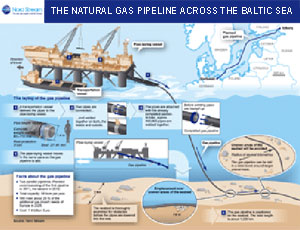Europe’s largest energy project, Nord Stream, this month received vital approvals from Sweden and Finland when they gave their OKs for the twin underwater pipelines to pass through their exclusive economic zones in the Baltic Sea.
Nord Stream will carry natural gas 1,220 km, from Vyborg, Russia, near St. Petersburg, to Greifsburg, Germany. It will cross the territories of four other nations: Sweden, Finland, Denmark and Poland. Only Russia and Germany still have to approve the project, but that is considered a formality.
The 1,220-km offshore section will consist of two parallel 48-in.-dia. pipelines. There will be a service platform in the Swedish zone, measuring 30 m x 30 m, 35 m above sea level. Nord Stream’s design engineering was done by Italy’s Snamprogretti, a subsidiary of Saipem.
Last year, two companies were awarded contracts to fabricate the pipe for the first of the two pipelines. Germany’s Europipe is supplying three-quarters, or 860,000 tonnes, of the steel, and Russia’s United Metallurgical Co. (OMK) will supply the remaining 280,000 tonnes. Pipe contracts for the second pipeline are expected to be awarded in January 2010.
Each pipeline will require 100,000 lengths of pipe, averaging 12 meters and weighing 12 tonnes each. The pipe will be delivered by rail to the ports of Kotka, Finland, and Mukran, Germany, near the terminus points. At the ports, the sections will be coated with concrete 60-mm to 110-mm thick, bringing their weight to 23 tonnes. About 30,000 pipe segments already have been fabricated, coated and stored.
Pipelaying is expected to begin in April 2010. Three specialized semisubmersible vessels will work simultaneously on separate segments. The pipe will be welded and laid on the seabed at a rate of up to three km per day. In areas where there is frequent marine traffic, the pipeline will be buried to protect it from anchor impacts. The deepest point along the route is 210 meters. Dutch marine contractor Royal Boskalis Westminster N.V. won the dredging contract in January 2009. It will excavate about 320,000 tonnes of rock to level and stabilize the seabed along the pipeline’s route.
The first pipeline is expected to be completed in late 2011. Pipelaying for the second line will start in 2011 and be completed in 2012. Each pipeline will carry 27.5 billion cu m of natural gas per year.
The project also involves onshore pipeline segments to connect the underwater lines to existing gas-distribution networks. The onshore segment in Russia is 917 km long. Two onshore transmission pipelines will be built in Germany, one to Olbernhau near the Czech border and another to Achim, for delivery to the Low Countries and the U.K. The underwater segment will cost $11 billion, and the three onshore segments will cost an additional $8 billion.
The owner, Nord Stream AG, is a company whose majority owner is Russian energy giant Gazprom, which holds a 51% share. The other partners are German firms BASF and E.ON (20% each) and N.V. Nederlandses Gasunie (9%).
As the first direct energy-supply link between Russia and western Europe, the project will increase western Europe’s dependence upon Russia. It also will reduce the influence of the countries hosting the traditional overland pipeline route for Russian gas: the Ukraine, Slovakia, Czech Republic, Belarus and Poland.
For more information, visit the project Website: http://www.nord-stream.com.



Post a comment to this article
Report Abusive Comment